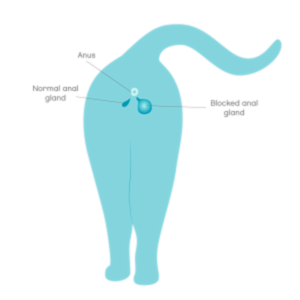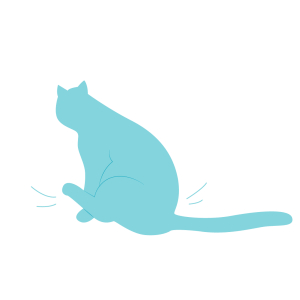Anal gland disease in cats
Overview
Symptoms
Risk
Diagnosis
Vet treatment
Home treatment
Recommended products
Prevention
When to worry
Anal gland disease in cats
Anal gland disease in cats can affect any age, breed, or sex. If caught early, it can be quick and easy to treat. Both male and female cats have two small pouches inside the anus called the anal sacs or glands. Their normal function is to release a few drops of liquid into the stools to give them a distinctive smell. This is most likely a way to mark their territory.

If the glands don’t empty when your cat passes stools, they fill up with secretion. This can cause irritation. If this happens, they will need emptying.
What is anal gland disease in cats?
The most common problem is when the glands fill up with a thin brown secretion. If this happens, the glands will usually need emptying by your local vet. This might involve sedation, but the symptoms should resolve completely. Cats can also develop anal gland infections, impactions, and abscesses.
Infections and impactions are usually found by your vet when they empty the glands. The liquid from the glands is usually different in colour and thickness.
Abscesses appear as a painful red swelling on the side of the anus. They may rupture and produce a sticky discharge that has blood in it.
Cats also get anal gland tumours, though these are not common.
Our Joii team are available 24 hours a day for advice. If your cat has anal gland symptoms, we may recommend a visit to your local vet. Especially if they have never had this problem before.
Symptoms of anal gland disease in cats
Scooting or rubbing their bottom on the ground: This can be a similar symptom for worms. Find out more about Worms in cats.
Biting or licking around the tail, back legs, and anus
Hair loss around the tail or tummy
Chasing their tail
Straining or discomfort when passing faeces

Find out other reasons why your cat may be scratching in our Itchy cats article
Are some cats at greater risk of anal gland disease than others?
The following factors can all lead to an increased risk of anal gland disease:
Low-quality or inadequate diets, or those with too little fibre
Soft stools, Diarrhoea, and infrequent bowel movements
Skin conditions, feline inflammatory bowel disease, Food allergies and environmental allergies.
Obesity
How is anal gland disease diagnosed in cats?
If the anal glands block, then they need to be emptied. We recommend an appointment with your local vet for this. This is usually very straightforward and should completely resolve the problem.
For the diagnosis of anal gland infections, your vet may take a swab. This will test for the type of infection and which medication will clear it.
For growths, tumours, or thickenings of the glands, your vet will take a biopsy to assess what type of cells are causing the abnormality. The biopsy result will usually show whether any further treatment is necessary.
We don’t recommend attempting to empty your cat’s anal glands yourself unless under veterinary advice. This can cause damage if it’s not done the correct way.
What’s the treatment for anal gland disease in cats?
Full anal glands
Your vet will empty the glands. The symptoms should resolve quickly, usually within 24 hours.
Anal gland impactions
The glands may need flushing under sedation, depending on the severity. Pain relief medication is often given.
Anal gland infections
Antibiotics are often used to clear the infection. These can be by mouth, by injection, or put directly into the anal glands by your vet. Pain relief medication is also used.
Anal gland abscesses
These are very painful, so they’ll need antibiotics and pain relief medication. Surgical treatment might also be required if the abscess has not already burst open.

For most anal gland problems, your vet will likely recommend a repeat check after a few days. This is to check that the problem has resolved.
How to look after a cat with anal gland disease at home
Use a warm compress on the bottom for 5-10 minutes. This can relieve some discomfort. Repeat this 2-3 times daily.
Keep the area around the bottom as clean and dry as possible.
Add fibre to the diet, such as canned pumpkin, bran flakes, or probiotic paste. This can help to firm up the stool in the short term.
Recommended products
Tips on how to prevent anal gland disease in cats
Good-quality, complete cat food is extremely important. Changes in the stools are one of the main causes of the glands filling up.
Use anal gland supplements for cats. These may prevent anal gland issues from returning.
Recurrent anal gland problems are rare in cats. Get the anal glands emptied regularly with your vet if they show symptoms.
If your cat doesn’t show symptoms of anal gland disease, there’s no need to empty them.
Keep your cat in a healthy body condition and provide adequate exercise. See the guide below to help assess your cat’s body condition.
Call our Joii team with any questions you have about preventing anal gland disease.
When to worry about anal gland disease in cats
Full anal glands are usually not urgent unless they are causing severe discomfort. If possible, make an appointment within 5 days to get them checked by your local vet. Anal gland abscesses can be very painful, so we recommend getting them checked with your local vet within 24 to 48 hours.
Joii can help if
You are unsure if your cat has anal gland symptoms.
You see any abnormalities around your cat’s bottom.
You have any questions about supplements used to help with anal gland problems.
You have any questions about your cat’s diet or weight.



















